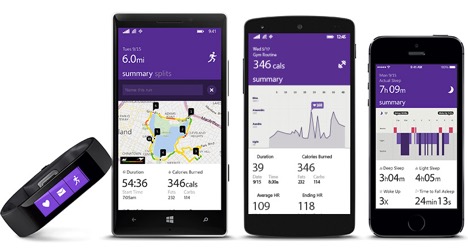“Wearables” have crept into the spotlight lately as Apple prepares to launch the Apple Watch next week, but even as an iPhone user, I’ve decided to go a slightly different route than some may expect.
Let me explain why.
What the Microsoft Band Is & Is Not
First, it’s important to make the distinction that the Microsoft Band is not a smart watch. It’s a fitness tracker, though it has some smart watch type features.
For example, it may not have the library of apps Apple Watch will offer, but it has a handful like calendar, Starbucks and alarm. From what I can tell, all the apps seem to be provided by Microsoft, so I’m not sure if that’s by design or if third-parties have just opted to not support it. It seems more the former.
Microsoft Band also works with not only Windows Phone, but Android and iOS devices. By downloading the Microsot Health app, you can sync Microsoft Band with your phone for fitness tracking, apps, themes and more.
One nice feature is the ability to sync your health data between Microsoft and other systems like MyFitnessPal. Microsoft even provides an online dashboard where you can check all of your fitness data and continue linking it with other services, similar to what you can do in the app. So no matter where you are, your data is with you. That’s not even mentioning that it’s all presented in a very easy and clean format, so you don’t have to be an expert to decipher anything.
You can also push notifications from your phone to your Microsoft Band from any device. This is what gives it more of a “smart watch” feel.
Finally, if you’re a Windows Phone user, you also get a couple extra features like Cortana and replying to messages right from Microsoft Band.
Lifespan
One of my biggest questions about the Apple Watch is, “how many years is it supposed to last me?”
Apple seems to operate under the assumption that people are upgrading their phones every two years. If you don’t, you’ll start to notice your phone running slow on the latest version of iOS.
To be honest, I don’t want another device I’m looking to upgrade every other year, especially one where the price isn’t subsidize by a contract. Who wants to spend $400 every two years?
The same problem could arise with Microsoft Band, but since it’s more of a fitness tracker than watch, it’s fair to say it’ll last a bit longer as its operating system isn’t going to advance beyond the hardware as quickly.
Price
The Microsoft Band is half the price – and less if you can find it on sale.
Add in the fact that I haven’t worn a device on my wrist since I first got a cell phone in 2002. It’s a bit difficult for me to invest $400 for a device that may annoy me and end up never using.

Battery Life
How long a device will last between charges is fairly important. I don’t really want something else I have to remember to plug in every night.
Until the Apple Watch is actually released, we can’t be certain just how long it’s battery will last. Apple is stating 18 hours, but those numbers are usually not entirely accurate.
By comparison, the Microsoft Band has a reported battery life of three days. That also allows it to be used to track your sleep, and to be honest, that’s a feature that really interests me.
Conclusion
Microsoft Band may end up just as a stepping stone for me, but it’s still a device I’m excited about. After reading numerous reviews, people seem generally happy with it when it comes to handling the functions it was designed to.
With a battery that won’t need charged nightly and the ability to track your sleep patterns, it even has features and functions the first Apple Watch will not.
Ultimately, it’s the price that is the selling point. For a product type I’m not even certain I need in my life, investing $200 is a bit more palitable than $400.
Will I eventually switch over? Maybe. I’ll have to see what changes in a year or two. There might be something entirely different at that point anyway.
